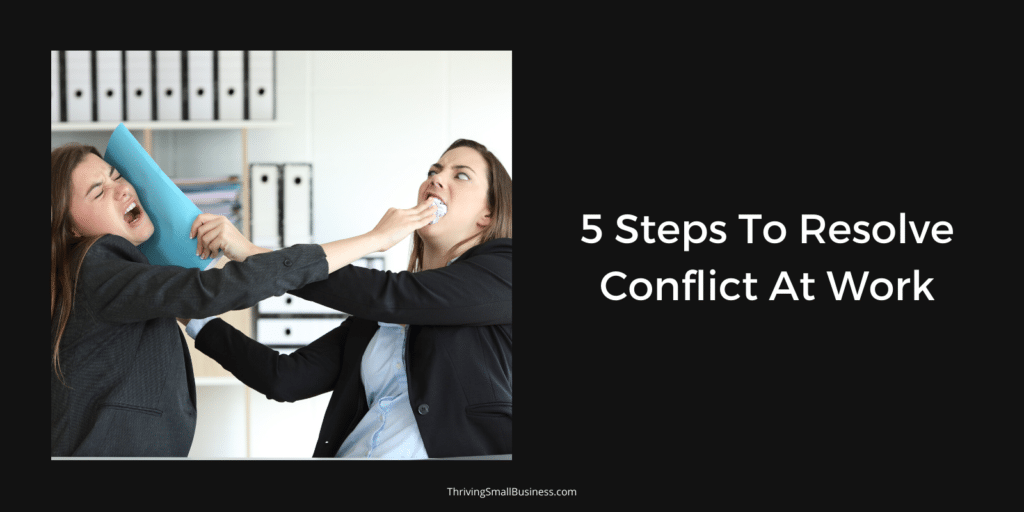Conflict Resolution In The Workplace
Estimated reading time: 5 minutes
Conflict in the workplace is an inevitable reality. This is why it is so important to understand what causes conflict in business and to have a conflict resolution plan in place to address it when it happens.
Conflict is defined as:
“To come into collision or disagreement; be contradictory, at
variance or in opposition; clash to fight or contend; do battle.”
Conflict can be the result of competition in the workplace.
Sources Of Conflict At Work
And, competition can come in a couple of ways.
Competition for resources – Battles often ensue over limited resources. These resources can be in the form of budget dollars, prime workspace, or available labor/employees.
Position – Competition can arise from an employee’s position, which may be their demonstration of ability, work skills, or influence in the work environment.
Relationships – Often, there is social competition. Employees try to demonstrate their relationships (popularity) with the boss, coworkers, vendors, and sometimes customers.
Personality – Let’s be real. We all have different social styles, and sometimes, the way we interact and communicate can be the source of conflict. Invest in social style training to help increase employee awareness of the different ways we all communicate.
If managed properly, conflict can add value to an organization.
For example, if employees hold back ideas and suggestions because they fear a negative response from others, it could hinder an organization’s creative process.
But if the culture embraces diverse thinking, it can generate innovative ideas.
Conflict can occur between co-workers, employees and managers, individual work groups and departments, or between an organization and a vendor.
Conflict is often the result of a disagreement over resources or how goals are accomplished.
But what drives the emotional response to conflict is often a difference in priorities, values, position, and personal style.
Underlying Organizational Issues
Conflict can be a manifestation of underlying organizational issues.
For example, unclear boundaries or inconsistent enforcement of policies can mean that employees are treated differently.

This results in resentment for different standards of behavior.
Conflict among co-workers creates distractions that can hinder an organization’s ability to meet corporate objectives.
And when conflict in the workplace is not managed, it can create stress, affect job performance, and be an underlying cause of a hostile workplace.
The goal of a workplace conflict resolution strategy is to find a win-win or a compromise, so that each party’s interests are met at some level.
5 Steps to Workplace Conflict Resolution
1. Separate The People From The Problem
It is important to separate the person from the conflict and remember that – it is about the process, not the person.
Focus on the issue and avoid tying the issue to a particular person or person(s).
For example, if there is conflict over limited resources, look at the process for how those resources are allocated and not the person vying for those resources.
If you can determine how and why (process), you will be able to communicate a fair distribution.
If the process is deemed unfair, relook at the process and strive to remove natural biases.
2. Identify A Mediator
Sometimes, conflict is at such a level that it warrants a neutral party to help mediate.
Ideally, try to identify someone who is trained in the mediation of people or groups of people. Use this expert to begin a conversation and work toward a resolution.
This might include establishing specific guidelines for personal interaction behaviors, as well as identifying any underlying issues that contribute to the conflict.
For example, I had an employee who was promoted to a supervisor and was having a difficult time managing someone who was once a co-worker.
The underlying issues dealt with the employee who felt like she had missed out on the promotion. Difficult to diagnose without intervention. But an issue that can be toxic to the work environment.
3. Clarify The Problem
It is important to take the time to hear all of the concerns and to get a good understanding of what the problem is.
Try to work toward identifying each party’s interests and not their position as it relates to the conflict.
Understanding another person’s interests (why it’s important to them) can help separate the person from the problem.
For example, if there are limited resources to support a team project, try to listen to concerns from each party about the potential impact those resources have and how it might affect their ability to achieve employee goals.
4. Explore All Options
Brainstorm ideas for ways of resolving the issue that would result in a win-win for all parties.
The goal is to make it a positive result for everyone involved.
This might include establishing criteria for determining fairness for the outcome.
For instance, initiate a conversation with both parties and simply ask the question:
- What does fairness look like to you?
- If you were me, how would you fairly distribute these limited resources?
The simple act of engaging in conversation that encourages employees to see things from a different perspective can often lead to resolution.
5. Agree On A Resolution
All involved parties should be part of the process to find and agree to a resolution.
This could be a verbal acknowledgment and agreement that the proposed resolution is the best solution to the problem.
A more formal process might be to have all parties sign off on the agreement in a written document.
Final thoughts.
- If it is an emotionally charged conflict, establish a cooling-off period for all involved parties before trying to resolve the issue.
- Discuss issues in a safe and neutral environment.
- Make sure all parties have the opportunity to share their concerns.
- Nip conflict in the bud because unresolved conflict can fester and reach a point of no return. This means that unresolved conflict can result in the necessity of removing a team member.
Organizations that have mastered the art of conflict resolution have a business advantage because positive conflict outcomes remove performance barriers and allow organizations to more quickly meet corporate objectives.






